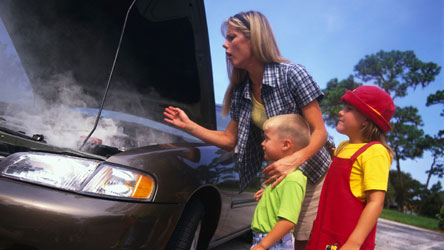Back home in New England folks are still dealing with subfreezing temperatures and blizzards. Here in the wonderful weather of northern Baja the birds are singing and spring comes early. It’s not too early to give some attention to your automobile to insure that while you’re sitting in the border crossing lines your vehicle doesn’t overheat. I’m specifically referring to your cooling system, often overlooked until lights are flashing. Then you notice the temperature gauge is pegged on hot, smoke is coming from your hood, and there are some strange noises is the cooling system.
Some checks you can do yourself, some you can’t, but it’s always better to know what needs to be done. There are a number of components that all need to be in good working order.
Every two years the coolant should be flushed and new coolant installed to specifications for your car, not your neighbor’s. If your car is still under warranty then you need to use what the owner’s manual recommends. The coolant is also an antifreeze with various additives to protect the engine metal.
Why do you need antifreeze in Rosarito you might ask? You don’t. But you will never find coolant without the antifreeze. Straight water is a big mistake. Coolant is mixed with distilled water at a 50/50 proportion. This is a list of the cooling system components and they all should be checked: radiator, fan, water pump, belts, upper radiator hose, lower radiator hose, the heater hoses, reserve or expansion tank, thermostat, and last, but not least is the pressure or radiator cap. Most cars today use a 14 to 15 PSI cap. That alone will raise the boiling point approximately 45 degrees F. Since coolant temperatures can climb to 250 to 275 degrees, and straight water turns to vapor at 212 degrees sea level, you need both a good cap and coolant mixture. (The older the car the greater the importance.)
You can do a visual check, one with the engine cold and one with the engine hot. Caution, I’ll write it again, caution, do not ever remove the radiator cap on a hot engine. On a cold engine look at the coolant level; look for any signs of leakage from the cooling system; inspect the belt that drives the water pump for signs of wear or fraying. Start the engine and let it warm up to normal then inspect for bubbles in both radiator and heater hoses.
If you have an electric fan, let it run paying attention to the temperature gauge. You are now checking to see if the electric fan is working and at what temperature it starts working. A minute after it starts you should see a drop in temperature on the gauge.
All other functional tests should be done by professionals. If your car has overheated, don’t let anyone talk you into simply removing the thermostat. If your garage tells you that, take it somewhere else. Happy Motoring!
 Baja Review A community newspaper serving Ensenada, Valle de Guadalupe, and Rosarito in Northern Baja California
Baja Review A community newspaper serving Ensenada, Valle de Guadalupe, and Rosarito in Northern Baja California





